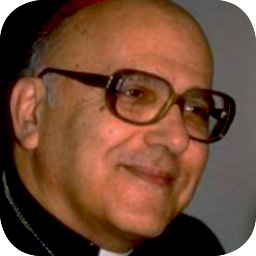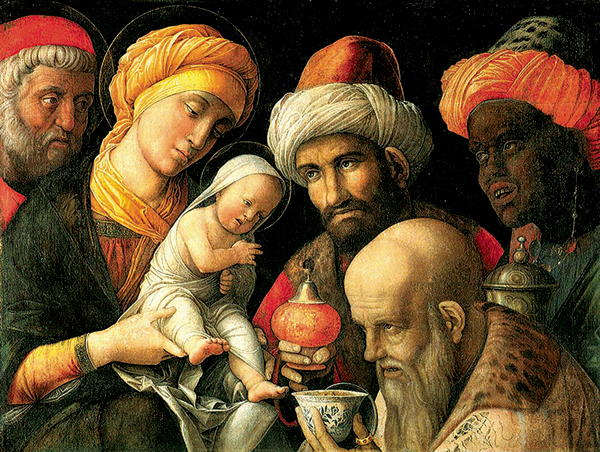Every day is a feast that we celebrate with gratitude. Palestinian Christians end the liturgical year with two feasts, honoring All Saints Day on November 1 and commemorating the dead on All Souls Day on November 2.
The main feasts for the Virgin Mary include the Annunciation on March 25, which recalls the appearance of Angel Gabriel to Mary in Nazareth as he announced that she would be the mother of the Incarnate Word of God, Jesus Christ (Lk 1:26–39; Jn 1:1–5, 14). This day is the feast of the city of Nazareth.
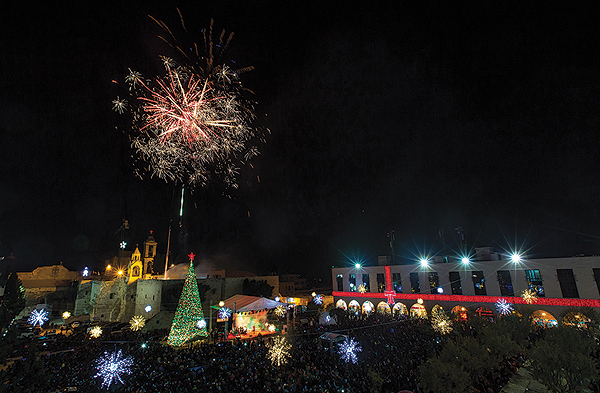
Assumption Day, on August 15, recalls the old tradition according to which the Virgin Mary was “assumed” (assumpted, Latin for “taken up”) into heaven in body and soul. In Jerusalem, two days before the feast, a funeral statue of the Virgin Mary is carried in a large, popular prayer procession from the Church of the Holy Sepulcher through the streets of the Old City to the Tomb of the Virgin Mary near the Garden of Gethsemane.
Christmas
Christmas commemorates the Nativity of Jesus Christ and is a very joyous celebration of spiritual renewal. It is preceded by a vigil day of penitence that entails the confession of sins and participation in the Mass and Holy Eucharist. Peripheral celebrations, which dominate almost everywhere, feature trees decorated with lights and exhibitions of the manger with the Infant Jesus, Virgin Mary, shepherds, the magi, and more. The Nativity is celebrated on December 25 and followed by the celebration of Epiphany on January 6. (See below for a discussion of the different calendars in use by various churches.) Epiphany denotes the “manifestation” of Jesus Christ to the world. Originally, Christians celebrated only one feast, Epiphany, which commemorated a number of events simultaneously: the nativity in Bethlehem (Lk 2:1ff), the visitation of the Magi, or Kings, from the East (Mt 2:1), the baptism of Jesus in the Jordan River by Saint John the Baptist (Lk 3:1ff), and the first miracle in Cana of Galilee, when Jesus manifested himself to his disciples (Jn 2:1ff). The Arabic name for Epiphany has kept one memory only, the baptism, hence the name ghitās (ÛØÇÓ) or “immersion in the water.” Christmas as a separate feast appeared in the fourth century; first in the West, then in all denominations. Today, the Western and Orthodox churches celebrate Christmas and Epiphany separately, whereas the Armenian Church celebrates only one feast, Epiphany.
♦ The main feasts of Our Lord Jesus Christ commemorate his Nativity, Passion and Death, Resurrection, and Ascension, as well as Pentecost. Christmas and Easter were declared national holidays in Palestine by President Arafat.
To understand why the Eastern and Western churches celebrate many of the same events on different days, we need to take a short excursion. Today, the Gregorian calendar, introduced by Pope Gregory XIII in October 1582, is followed throughout the world in secular matters, and for Catholics and Protestants it determines the dates of religious feasts. The Julian calendar was introduced in 46 BC by the Roman General Julius Caesar (100–44BC) and is used by the Orthodox churches to determine the dates of their feasts. Both calendars originated in Rome, but one is pagan (Julius Caesar) whereas the other is Christian (Pope Gregory XIII).
Thus, in fact, the Catholic, Orthodox, and Protestant churches all celebrate Christmas on December 25 and Epiphany on January 6. But because there is a difference of 13 days between these two calendars, Christmas falls on December 25 for Catholics and Protestants and on January 7 (25+13) for the Orthodox, whereas Epiphany is celebrated on January 6 by Catholics and Protestants and on January 19 (6+13) by the Orthodox. As Armenians commemorate Christmas and Epiphany together, they celebrate on January 19.
Lent, Holy Week, and Easter
The second main feast is the Resurrection on Easter. It is preceded by Lent, a time of fasting, special penitence, and prayer, as the faithful wish to share in the sufferings both of Jesus Christ and of people in their own land and all over the world. Lent culminates in Holy Week, during which the passion and suffering of Our Lord Jesus Christ are commemorated. Easter occurs between March 22 and May 1, and its date differs not only from year to year but also between the individual churches. It is based simultaneously on the lunar and solar calendars, and the annual difference is due to lunar cycles shifting in the solar calendar. The difference between Eastern and Western churches is caused by the use of the different calendars, and thus celebrations of Easter may happen on the same Sunday or may differ by one to five weeks.
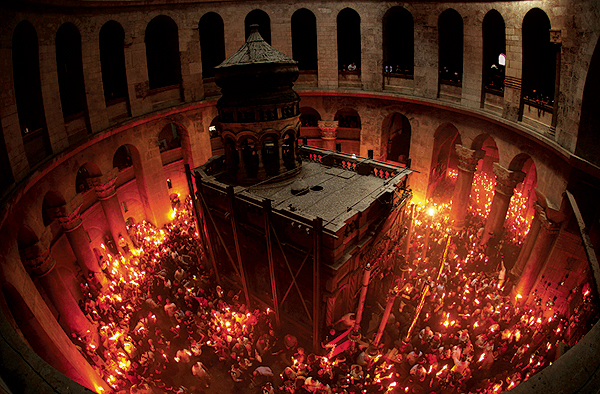
Holy Week begins with Palm Sunday, which records Jesus entering Jerusalem amidst the warm welcome of its people, as narrated in the Gospel (Jn 12:12ff). In Jerusalem, a morning celebration takes place in the Basilica of the Resurrection; in the afternoon a solemn procession begins in Bethfage on the outskirts of Jerusalem, according to the narration of the Gospel, and moves through the village of At-Tour; it then proceeds down to the Garden of Gethsemane, and ends at the Basilica of Saint Anne, the place nearest to where the old temple is believed to have stood. Traditionally, thousands of locals and pilgrims walked in the procession, but today, the numbers of locals are limited because military permits to allow participation are given only to a few Palestinians.
♦ Many faithful consider Easter the most important Christian feast because without the Resurrection there would be no special meaning to the Nativity.
Holy Week ends in the Triduum, three days that include Holy Thursday, Good Friday, and Holy Saturday. On Thursday, Christians remember the last day in the earthly life of Jesus, when he held the Last Supper and established two main institutions in Christian faith: the Eucharist (a real, sacramental permanence of His presence on earth in the Blessed Sacrament), and the Priesthood, as the twelve Apostles were given the priestly power of Jesus. During this night, Jesus also gave his last commandment asking his followers to love each other and all people, and washed the feet of his disciples (Jn 12:1ff).
The washing of feet is still done in all parishes by priests and bishops who, having read the gospel, wash the feet of twelve members of the community. In Jerusalem, the Greek Orthodox patriarch performs the ceremony in the courtyard of the Holy Sepulcher before twelve bishops who are seated on a high podium and dressed in their liturgical attire. The patriarch, helped by deacons, washes their feet before a large crowd and the media. The Roman Catholic Latin patriarch accomplishes the same rite inside the Basilica during mass, after the reading of the Gospel. He washes the feet of twelve seminarians who are seated on two opposite benches before the Sepulcher.
Good Friday is called thus to indicate that this is the good day, the day on which Jesus offered his life to redeem humanity from evil and sin. In Arabic it is called Great Friday or Sad Friday. It is a day of prayer, penitence, and fasting. In Jerusalem, a liturgy is celebrated by the patriarch and the narration of the passion (suffering) is read on Calvary, a chapel inside the Church of the Holy Sepulcher that denotes the place where Jesus was crucified and died. Afterwards, the people walk and pray “the Way of the Cross.” They follow fourteen stations located on the streets of Jerusalem, recalling the path Jesus followed from the palace of the Roman governor Pilate (said to be where the Umariyya School is located today) up to Calvary. In the evening, in the Basilica of the Holy Sepulcher and in all parishes of Palestine, a popular ancient tradition is celebrated with a procession in which a funeral statue of Jesus, covered with flowers and perfumes, is carried amidst prayers and funeral dirges.
The main celebration on Holy Saturday, also called Saturday of the Resurrection, is the Ceremony of New Light. In the Roman Catholic Latin rite, burning coals are prepared at the entrance of the Church of the Holy Sepulcher. After all other lights have been extinguished, the patriarch, assisted by other celebrants, in a symbolic gesture takes the new light from the coals. A big Pascal Candle is lit before the candles of the patriarch, other celebrants, and all the faithful. Then the Pascal vigil prayer starts with biblical readings and a Holy Mass. Originally, this prayer was a vigil prayer that lasted from late night until dawn of the Resurrection Day.
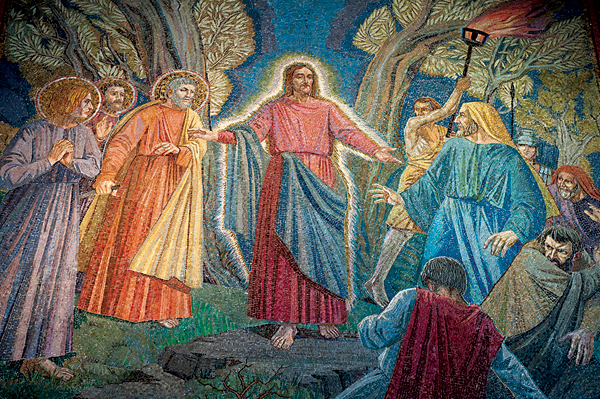
In the Greek Orthodox rite, appropriate preparations are made and all lights are extinguished before the patriarch, accompanied by bishops and clergy, enters the Chapel of the Tomb. According to ancient tradition the new light suddenly appears from inside the tomb in a miraculous way while he prays. The patriarch then exits the tomb chapel bearing the new light. Many faithful are there to take the new Pascal Light from this candle and carry it to other churches that may be in Palestine, Athens in Greece, or Moscow in Russia, or any other place in the world. In many parishes, religious and civil local authorities welcome this new light from the Holy Sepulcher with festivities and celebrations.
Easter Day marks the day of Resurrection, Jesus’ triumph over sin and death. People greet each other on the day of Resurrection and all week long with the words al-Masih qām (Christ is risen), to which the answer is Haqqa-n qām (indeed he is risen). The message of Holy Week and Easter is spiritual, calling the faithful to renew their lives and to fill them with hope and joy. But it also carries the social and political message of strength, empowerment over evil and sin, and hope for freedom and an end to political oppression or military occupation.
Ascension and Pentecost
Jesus terminated his earthly stay by ascending to heaven (Acts 1:9ff), the memory of which is celebrated forty days after Easter on the feast of the Ascension. Because today the place of the Ascension is marked by a mosque, once a year, on Ascension Day, the Muslim authority of the mosque allows Christians to pray on the site. Pentecost is celebrated ten days after the Ascension, fifty days after Easter (Acts 2:1ff). The word Pentecost literally means the fiftieth day, while the Arabic name Ansara is of Aramaic origin and means reunion or meeting. On this day the Apostles had gathered, along with Mary the mother of Jesus, in prayer on Mount Sion when the Holy Spirit descended upon them. Empowered by the Holy Spirit, the Apostles subsequently followed Jesus’ command and went out to preach Christ the Savior who had died and was resurrected from among the dead. This feast is considered to commemorate the foundation of Christianity: on Pentecost day in Jerusalem, all churches, all Christians were born.
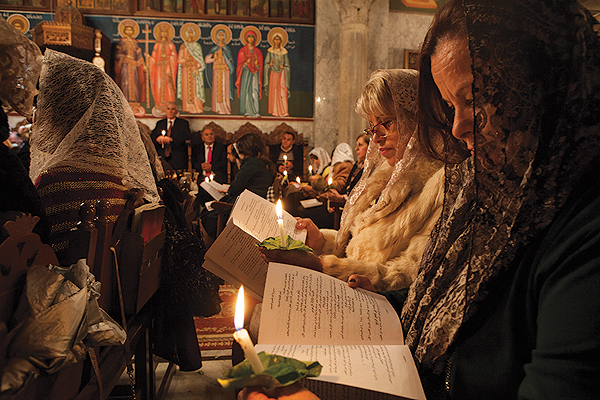
♦ On Christmas and Easter, the patriarchs and heads of churches in Jerusalem deliver a shared message to all Christians and to all people of good will, insisting on the spiritual meaning of the feasts and on their message of justice and peace for all.
These are the main Christian annual celebrations. These religious celebrations are days for expressions of joy and occasions of spiritual renewal. This renewal includes political dimensions when people live under political oppression, as is the case for Christian Palestinians and indeed for all Palestinians. On the days of religious celebrations, prayer is a call for peace and justice and for resistance to subjugation. It is a call to humans to be more present before God Almighty, to abandon domination and violence, and to become more fully human, full of life and love.
» His Beatitude Patriarch Michel Sabbah was the Latin (Roman Catholic) Patriarch of Jerusalem from 1987 to 2008. He holds a PhD in Arabic philology. Patriarch Sabbah calls for rapprochement between churches, interreligious dialogue, and justice and peace.

